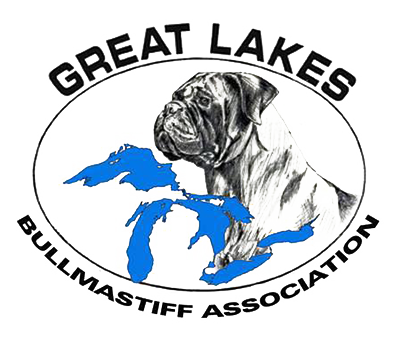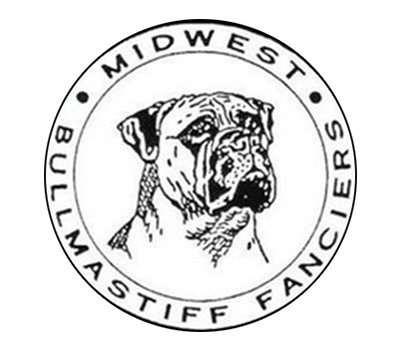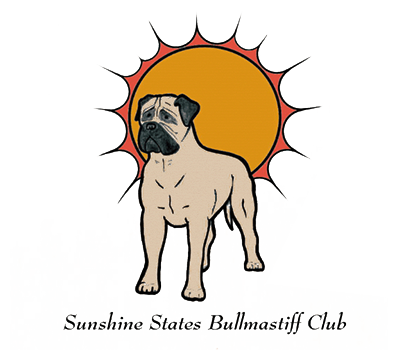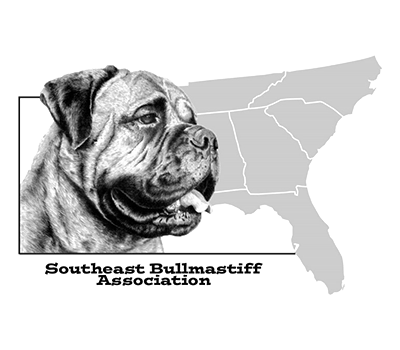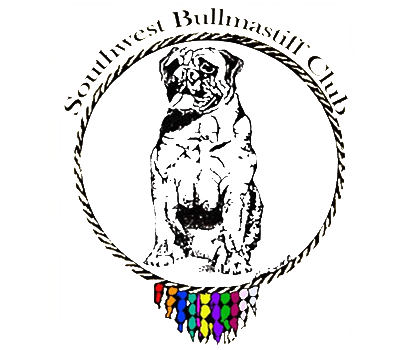The Breed
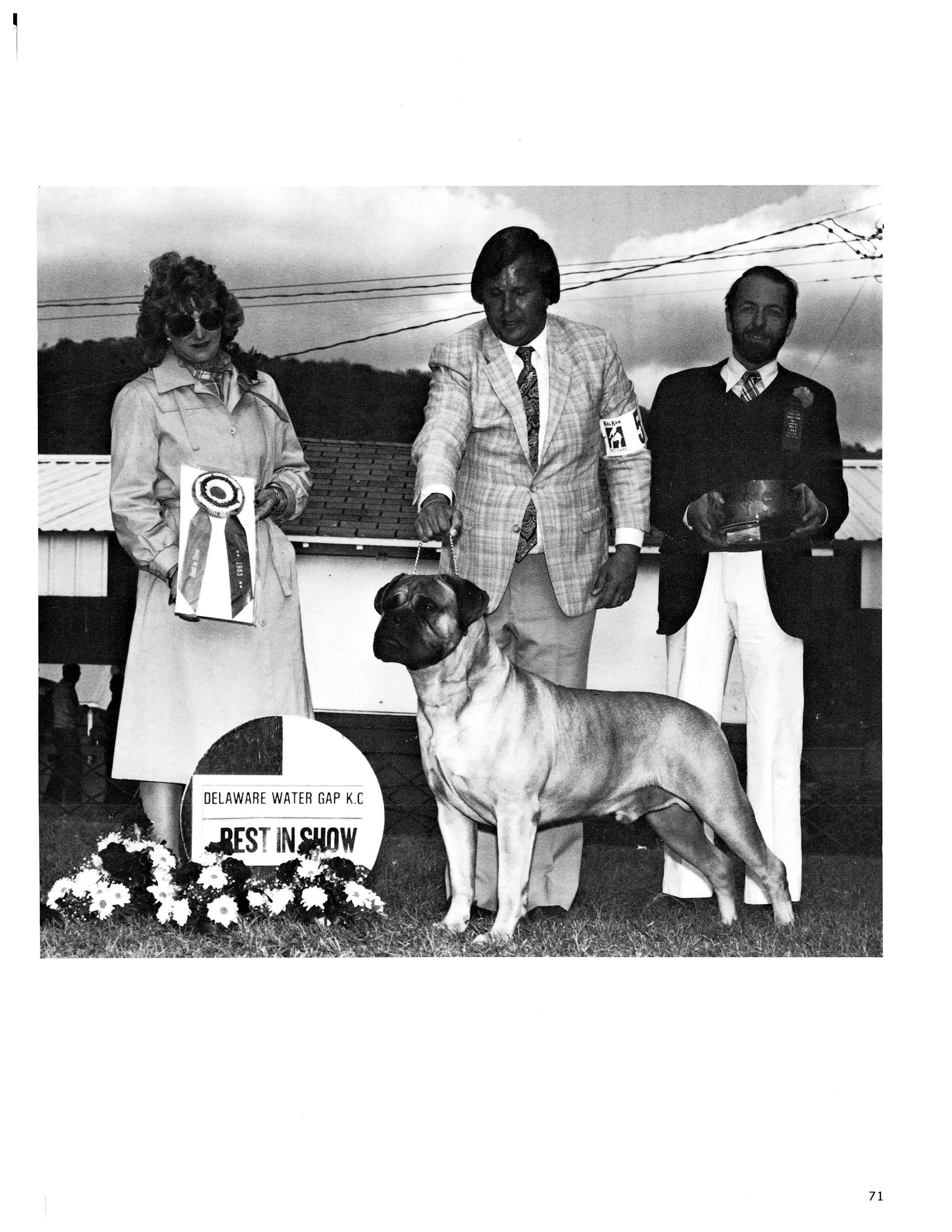
About The Breed
The Bullmastiff is a large-sized breed of domestic dog, with a solid build and a short muzzle The Bullmastiff shares the characteristics of molosser dogs, and was originally developed by 19th-century gamekeepers to guard estates. The breed’s bloodlines are drawn from the English Mastiff and the extinct Olde English Bulldog. It was recognized as a purebred dog by the English Kennels Club in 1924 and by the AKC in 1934.
History Of The Breed
The known history of the Bullmastiff begins about the year 1860 in England. It is probable that the story of the breed is centuries old. The Bullmastiff was bred to aid gamekeepers in protecting the game on large English estates. Poaching on the estates was an expensive problem for the landowners, and it was the gamekeeper’s duty to catch the thieves. Gamekeepers needed a dog that could track quietly, cover short distances quickly, and pin and hold poachers without mauling them.
Gamekeepers experimented with several breeds, looking to the mastiff, who was too slow, and then the bulldog, who was at the time a more ferocious dog than he is today–too ferocious. Out of these breeds, the Bullmastiff was born. He combined the best of both breeds for the job required of him. He is now primarily a family companion with a calm, dependable disposition when properly trained and socialized. The Bullmastiff was accepted as a recognized breed of the American Kennel Club in October 1933.
At the time of its creation, there were many large estates in England, the owners of which frowned upon the game in their estates being poached. Gamekeepers were employed to oversee and protect the game in the estates and they needed an able assistant; the poachers being a rather dangerous lot since punishment for poaching was hanging. Mastiffs were tried but found to be somewhat slow and to not have the drive necessary to down and hold a man. Bulldogs (a quite different type than we see today) were tried, but the bulldog of that era was very ferocious and tended to tear the poacher up too much.
So, crosses were made of the Bulldog and Mastiff until a ratio of 60% Mastiff/40% Bulldog was achieved. This type of dog, eventually called the Bullmastiff, served the needs of the gamekeeper very well. The dog could track a man in the forest at night; work quietly; and, when close enough spring to a hard charge, knocking the man down and holding him there until the gamekeeper arrived. This was no mean feat since the poachers used every trick and tool at their disposal to escape, knowing that they faced hanging. The Bullmastiff had to be very brave and tenacious and more than one suffered death at the hands of a desperate criminal. But, the breed was exactly what the gamekeeper needed and they did their job well.
FAQ: Getting To Know The Bullmastiff
The definition of temperament is that it is ones basic nature or disposition. Temperament is certainly not the same from breed to breed. Because of the work or purpose of each breed, the temperament of each breed varies. Dogs were developed with not only certain physical characteristics, but also mental characteristics for the work intended for them.
The Bullmastiff was bred as a guard, and has the temperament suited for that job. They are possessive, territorial, loyal dogs with an innate sense of who does and who doesn’t belong on one’s property. They seem impelled to stop intruders, yet are (or certainly should be) more than willing to accept those people accepted by their masters.
The Bullmastiff standard describes the breed temperament as “fearless and confident, yet docile. The dog combines the reliability, intelligence, and willingness to please required in a dependable family companion and protector.”
If we follow the description of temperament in the standard, we are describing a dog that will have no hesitation in protecting what he considers his own (family, friends, territory), he is sure of his abilities to do so, and can be controlled without undo effort. He is a dog we can depend on to be consistent in his responses, bright enough to learn what we want, and willing to do what we ask, for whatever reason he attaches to that willingness.
Bullmastiffs, being the territorial, possessive creatures that they are, seem happy to do their guarding on any sized property. They are just fine as long as they understand their position in the family hierarchy, and that position is the proper one. The worst thing that can happen to a Bullmastiff is to belong to someone who is incapable of commanding that dog’s obedience and respect. The dog is first AFTER ALL THE PEOPLE IN THE HOUSEHOLD.
THE BULLMASTIFF IS NOT THE BREED FOR EVERYONE. There is nothing wrong with the Bullmastiff being strong-willed, possessive and territorial. That is the breed’s temperament. On the plus side, there are very few strong-willed dogs who are dumb. On the minus side, if this type of dog ends up with wishy-washy or inappropriate people, there is going to be a problem.
The Bullmastiff is a wonderful breed. Its temperament is ideal for its purpose in life. It needs a home where it is made to understand from the beginning (the second one takes possession) that it is loved, wanted and a part of the household, but as such will obey because that’s the way life is. As with small children, security comes from knowing ones boundaries. A dog that understands its position in the pack (family) is secure and happy. It is a safe pet. It follows the lead of its family superiors.
A strong-willed, fearless and confident dog such as the Bullmastiff is a joy to own, if owned by someone worthy and capable of owning a dog of this temperament.
Taken from “Bullmastiff Temperament” by Carol Beans
Some common questions:
Do they drool?
All dogs drool, but sometimes Bullmastiffs may drool more often than other breeds.
How big do they get?
The breed standard calls for a dog that is between 25-27″ for a male and between 24-26″ for a female. Weights are between 110-130# for a male and 100-120# for a female. However, there are many Bullmastiffs that fall either under the standard or over the standard. So you may see a female as small as 22″ tall and 85# or a male as large as 29″ tall and 170# or more. Ideally, a breeder breeds to the breed standard and the pups that may fall outside the parameters of the standard are placed as companion animals.
How much food do they eat?
An adult Bullmastiff usually eats between 2-3 cups of dry kibble twice a day. This averages out to 40-60# of dog food per month. Some may eat more and some may eat less. Each dog is different so you need to gauge the amount of food to the size of the dog. The important thing to remember is do not let your Bullmastiff become overweight.
Do they get along with other dogs?
Bullmastiffs do not always get along with other dogs. If you already have a dog in your household, most responsible breeders will recommend getting a bullmastiff that is the opposite sex. There are always exceptions and breeders know their puppies best, but in general it’s not advised to have multiple males in a household.
Do I have to show my dog?
If you are interested in showing a dog, then work with your breeder on getting the best quality pup you can. Most breeders will gladly help you along the way in this wonderful sport. Most breeders keep their pick pups, so it could take a year or more to get just the right pup for you. Be patient. Let you breeder help you and teach you. They are your mentor.
If you do not want to show a dog, then be up front with the breeder. Do not sign a show contract. Many people want a show quality pup and because you are getting a companion animal doesn’t mean that it is a lesser quality. Tell the breeder what you want. Many top quality show prospects go to pet homes to be wonderful couch ornaments.
Are they good family dogs?
Yes! This breed needs to be an integral part of the family unit. This breed IS a guard breed and does require a lot of early socialization so that they become accepting to everyone you invite into your home. They are very rough as puppies and may knock small children down without even noticing. They would protect you with their life, if the need ever arose.
Do I need to take my dog to obedience school?
YES!!! Obedience training is in a class situation and provides socialization as well as valuable training. If your dog is not under control, he may knock someone down and hurt them.
What colors do they come in?
The recognized colors are red, fawn and brindle. They should have a black mask and dark eyes, ears and nails. (see the AKC Breed Standard)
How much exercise do they need?
This breed requires moderate exercise. As a pup, start with very slow short walks, then increase the length of the walk as the dog gets older. Do not attempt any high impact events until the dog is well over 18 months of age.
How do I find a reputable breeder?
Do your homework. Interview each breeder you talk to. Make up your own set of questions before you talk with them. (see ABA accredited breeder section of this website) The breeder will have a set of questions to ask you. Do not be offended by these questions as they are being asked to protect the pup! This pup will be a part of your family. Make sure your breeder will be available to answer your many questions, no matter how silly you may think they are (no question is EVER silly). If the breeder states that their dogs have certifications on hips, elbows, eyes, thyroid, cardiac, etc, ask to see the certifications. If they cannot provide you with copies, then the dogs do not have those health clearances and you should be wary of them. If the breeder has a contract, go over each clause with that breeder. There may be clauses in that contract that you do not understand or agree with. If you do not feel comfortable with those clauses, talk about them with the breeder and come to an agreement. If this cannot be done then DON’T take the pup. DO NOT IMPULSE BUY.
AKC Breed Standard

General Appearance: That of a symmetrical animal, showing great strength, endurance, and alertness; powerfully built but active. The foundation breeding was 60 percent Mastiff and 40 percent Bulldog. The breed was developed in England by gamekeepers for protection against poachers.
Size, Proportion, Substance: Size-Dogs, 25 to 27 inches at the withers, and 110 to 130 pounds weight. Bitches, 24 to 26 inches at the withers, and 100 to 120 pounds weight. Other things being equal, the more substantial dog within these limits is favored.
Proportion: The length from tip of breastbone to rear of thigh exceeds the height from withers to ground only slightly, resulting in a nearly square appearance.
Head: Expression-Keen, alert, and intelligent. Eyes-Dark and of medium size. Ears-V-shaped and carried close to the cheeks, set on wide and high, level with occiput and cheeks, giving a square appearance to the skull; darker in color than the body and medium in size. Skull-Large, with a fair amount of wrinkle when alert; broad, with cheeks well developed. Forehead flat. Stop-Moderate. Muzzle-Broad and deep; its length, in comparison with that of the entire head, approximately as 1 is to 3. Lack of foreface with nostrils set on top of muzzle is a reversion to the Bulldog and is very undesirable. A dark muzzle is preferable. Nose-Black, with nostrils large and broad. Flews-Not too pendulous. Bite-Preferably level or slightly undershot. Canine teeth large and set wide apart.
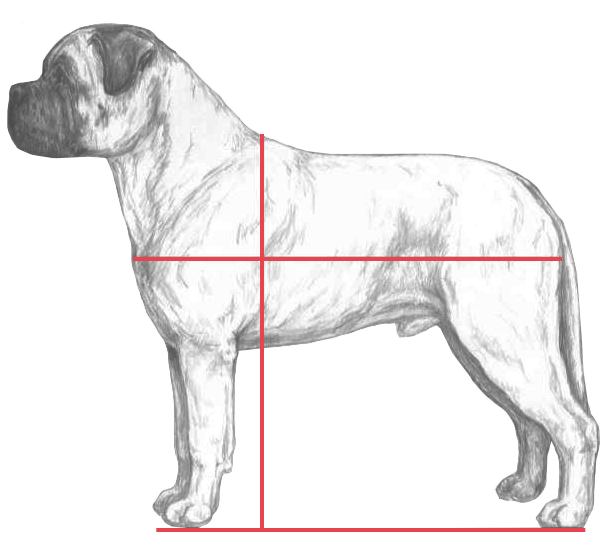
Neck, Topline, Body: Neck-Slightly arched, of moderate length, very muscular, and almost equal in circumference to the skull. Topline-Straight and level between withers and loin. Body-Compact. Chest wide and deep, with ribs well sprung and well set down between the forelegs. Back-Short, giving the impression of a well-balanced dog. Loin-Wide, muscular, and slightly arched, with fair depth of flank.Tail-Set on high, strong at the root, and tapering to the hocks. It may be straight or curved, but never carried hound fashion.
Forequarters: Shoulders-muscular but not loaded, and slightly sloping. Forelegs-straight, well boned, and set well apart; elbows turned neither in nor out. Pasterns straight, feet of medium size, with round toes well arched.Pads thick and tough, nails black.
Hindquarters: Broad and muscular, with well-developed second thigh denoting power, but not cumbersome. Moderate angulation at hocks. Cowhocks and splay feet are serious faults.
Coat: Short and dense, giving good weather protection.
Color: Red, fawn, or brindle. Except for a very small white spot on the chest, white marking is considered a fault.
Gait: Free, smooth, and powerful. When viewed from the side, reach and drive indicate maximum use of the dog’s moderate angulation. Back remains level and firm. Coming and going, the dog moves in a straight line. Feet tend to converge under the body, without crossing over, as speed increases. There is no twisting in or out at the joints.
Temperament: Fearless and confident yet docile. The dog combines the reliability, intelligence, and willingness to please required in a dependable family companion and protector.
Approved February 8, 1992 | Effective March 31, 1992






